Space Weather Effects on Heart Rate Variations: Sex Dependence
Abstract
:1. Introduction
2. Data and Method
2.1. Medical Data
2.2. Cosmic Ray Intensity Data
2.3. Geomagnetic Activity Data
2.4. Statistical Method
3. Results
- (1)
- HR increase was observed for the highest levels of GMA (level IV of the Dst- and Ap index classification),
- (2)
- HR increase was observed during strong CRI decreases (i.e., decreases from −6% to −3%),
- (3)
- For levels III and IV of the GMA and strong CRI decreases, HR varied significantly on the days before (−), during (0), and after (+) the registered events,
- (4)
- p-values showed that HR is statistically significantly affected by GMA during the days before the geomagnetic storm and by CRI variations during the day of the event and the days after that,
- (5)
- HR was more susceptible to geophysical events during the ascending phase of solar cycle 24 (p-values showed that the GMA and CRI variations statistically significantly affected HR during the ascending and not the descending phase). This is because Forbush decreases, and geomagnetic storms are mostly displayed during and around the solar cycles’ maximum when intense solar activity is registered [48].
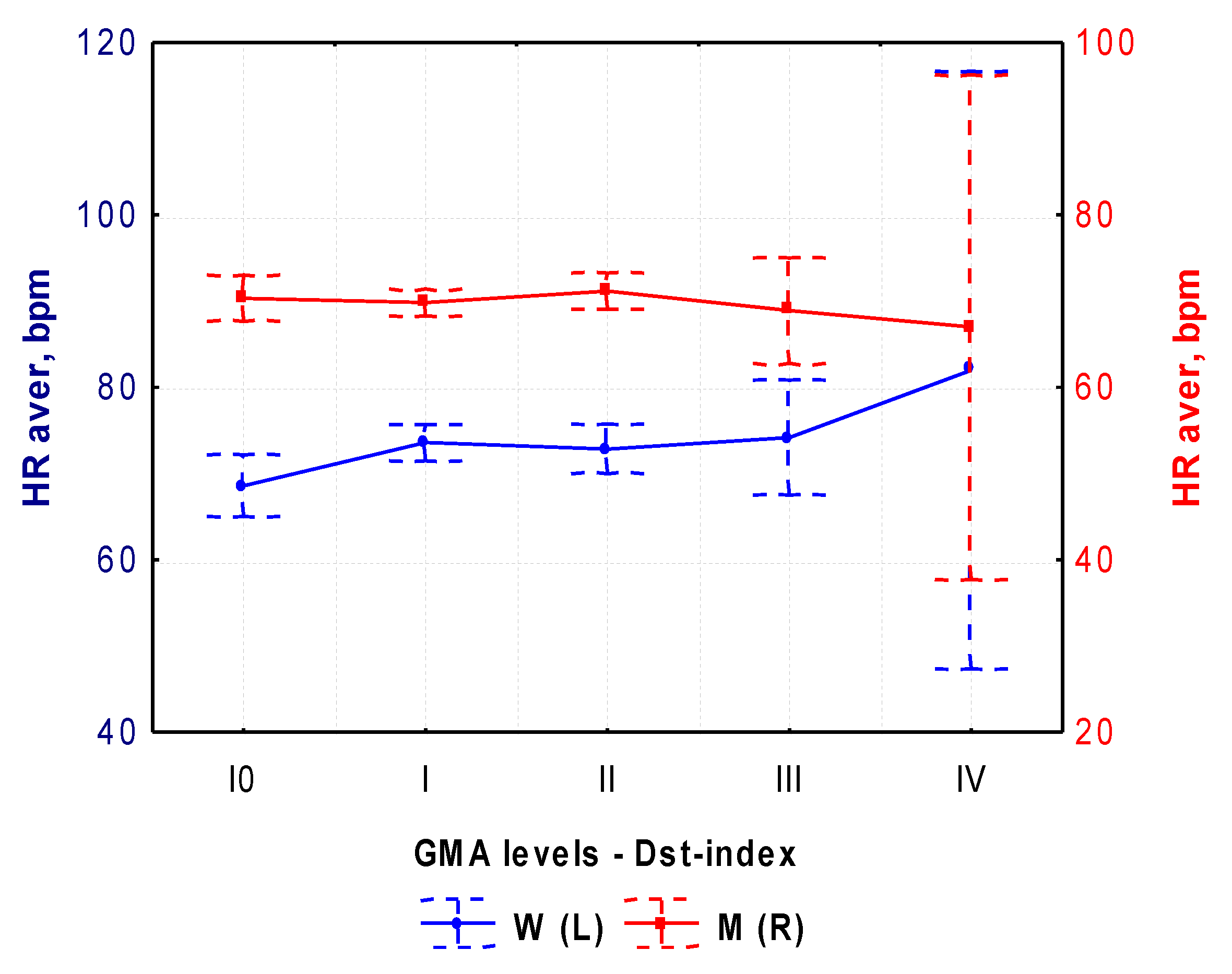
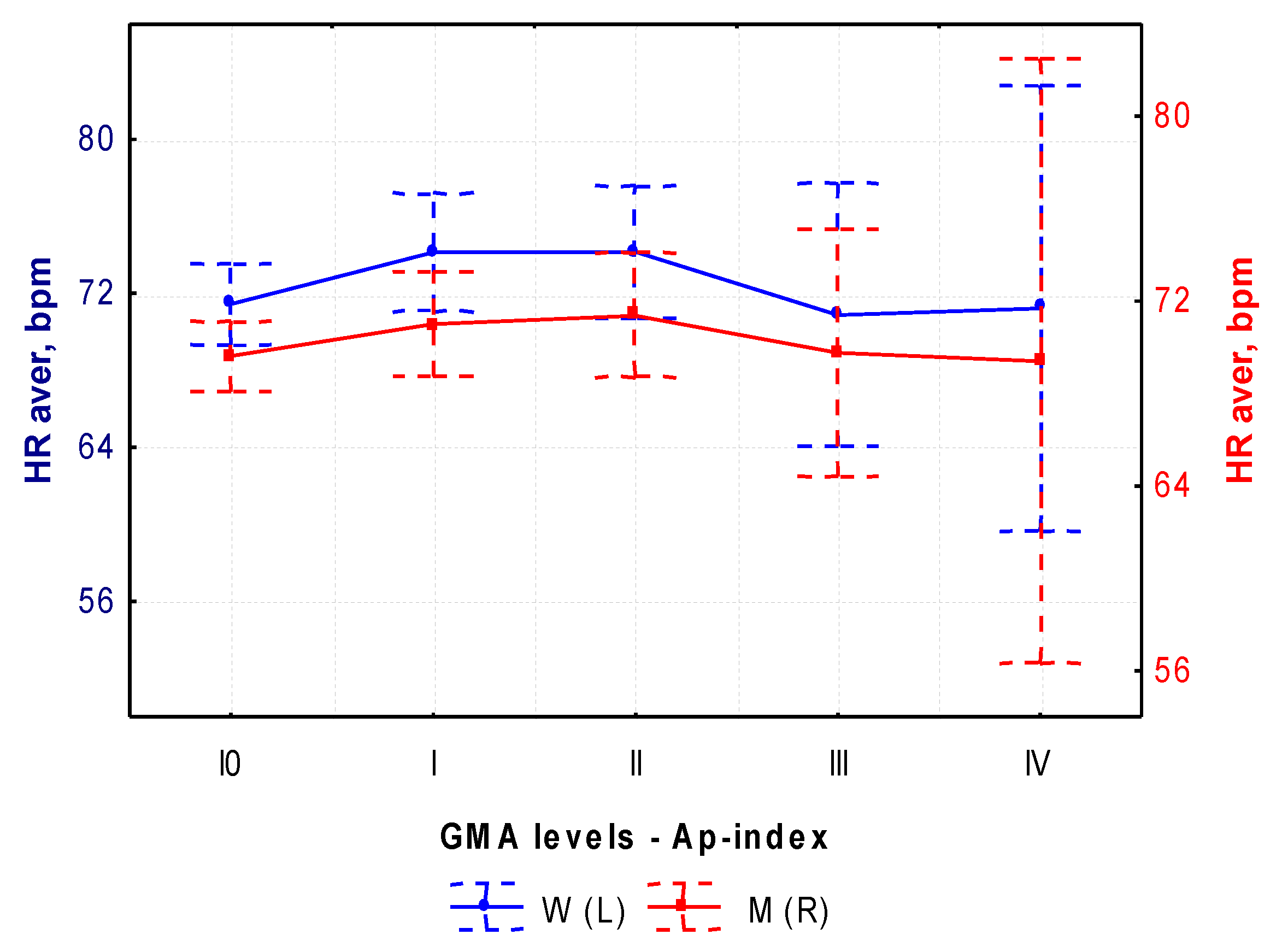


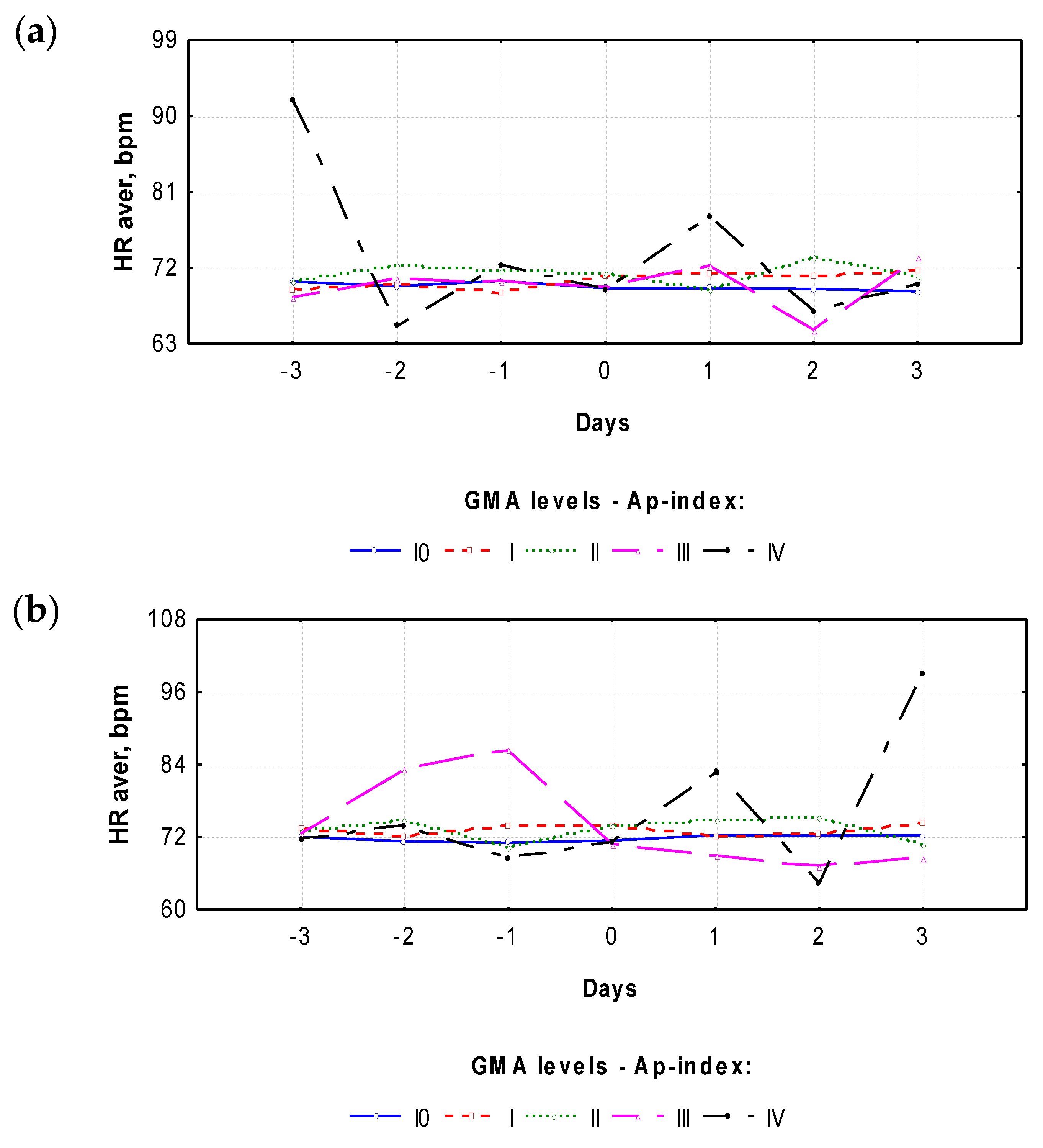
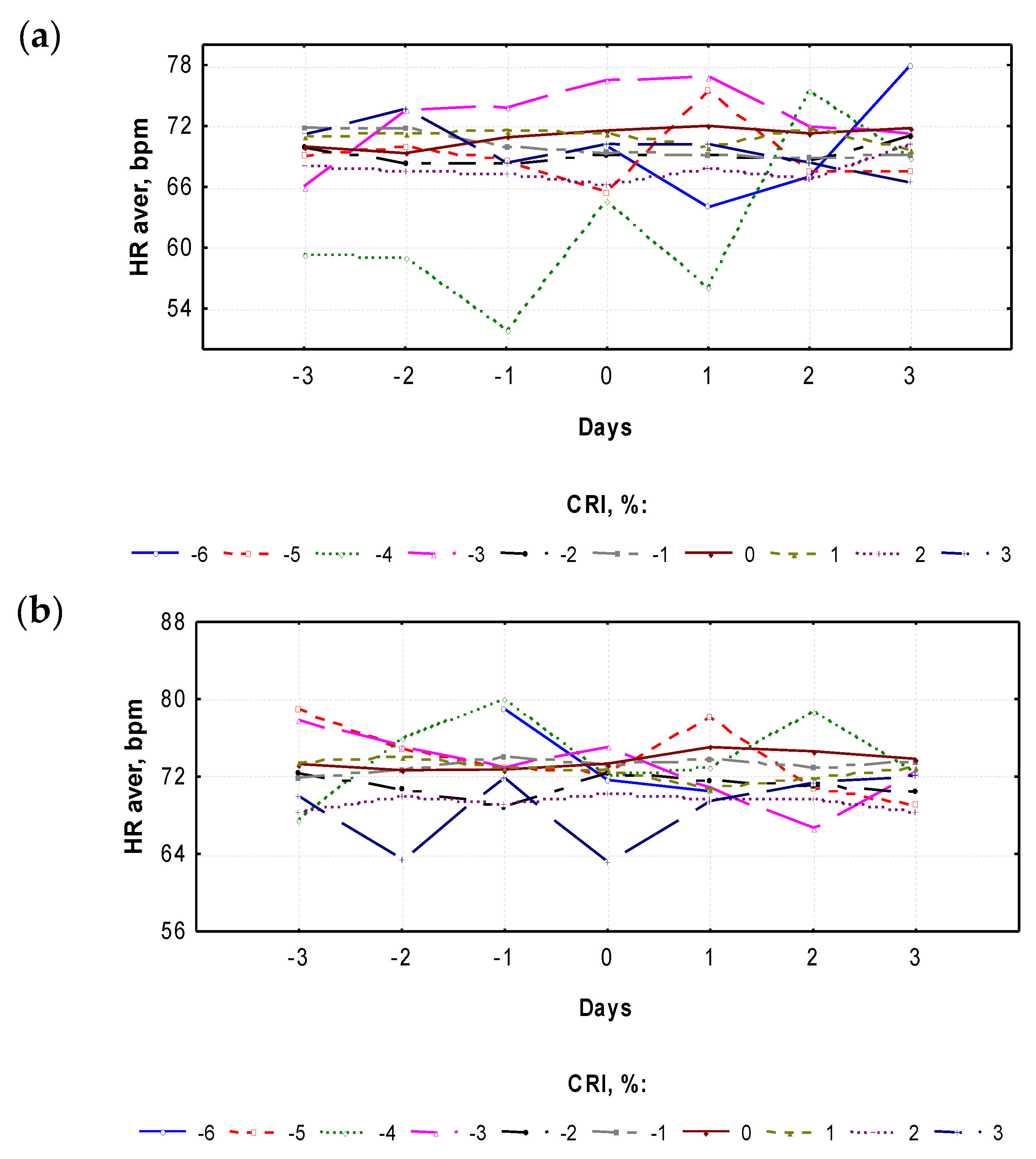
4. Conclusions and Discussion
Author Contributions
Funding
Institutional Review Board Statement
Informed Consent Statement
Data Availability Statement
Acknowledgments
Conflicts of Interest
References
- Gnevyshev, M.N.; Novikova, K.F. The influence of solar activity on the earth’s biosphere (Part I). J. Interdiscip. Cycle Res. 1972, 3, 99–104. [Google Scholar] [CrossRef]
- Chirkova, E.N. Mathematical methods of detection of biological and heliogeophysical rhythms in the light of developments in modern heliobiology: A platform for discussion. Cybern. Syst. Anal. 1995, 31, 903–918. [Google Scholar] [CrossRef]
- Zhadin, M.N. Review of Russian literature on biological action of DC and low-frequency AC magnetic fields. Bioelectromagnetics 2001, 22, 27–45. [Google Scholar] [CrossRef] [PubMed]
- Sergeenko, N.P. Heliogeophysical Conditions in Moscow during the COVID-19 Pandemic. Izv. Atmos. Ocean. Phys. 2022, 58 (Suppl. S1), S42–S51. [Google Scholar] [CrossRef] [PubMed Central]
- Stoupel, E. Effect of geomagnetic activity on cardiovascular parameters. J. Clin. Basic Cardiol. 1999, 2, 34–40. [Google Scholar] [CrossRef] [PubMed]
- Kleimenova, N.G.; Kozyreva, O.V.; Breus, T.K.; Rapoport, S.I. Pc1 geomagnetic pulsations as a potential hazard of myocardial infarction. J. Atmos. Sol. Terr. Phys. 2007, 69, 1759–1764, ISSN 1364-6826. [Google Scholar] [CrossRef]
- Katsavrias, C.; Preka-Papadema, P.; Moussas, X.; Apostolou, T.; Theodoropoulou, A.; Papadima, T. Helio-geomagnetic influence in cardiological cases. Adv. Space Res. 2013, 51, 96–106, ISSN 0273-1177. [Google Scholar] [CrossRef]
- Vieira, C.; Alvares, D.; Blomberg, A.; Schwartz, J.; Coull, B.; Huang, S.; Koutrakis, P. Geomagnetic disturbances driven by solar activity enhance total and cardiovascular mortality risk in 263 U.S. cities. Environ. Health 2019, 18, 83. [Google Scholar] [CrossRef]
- Kiznys, D.; Vencloviene, J.; Milvidaitė, I. The associations of geomagnetic storms, fast solar wind, and stream interaction regions with cardiovascular characteristic in patients with acute coronary syndrome. Life Sci. Space Res. 2020, 25, 1–8, ISSN 2214-5524. [Google Scholar] [CrossRef]
- Vencloviene, J.; Radisauskas, R.; Vaiciulis, V.; Kiznys, D.; Bernotiene, G.; Kranciukaite-Butylkiniene, D.; Tamosiunas, A. Associations between Quasi-biennial Oscillation phase, solar wind, geomagnetic activity, and the incidence of acute myocardial infarction. Int. J. Biometeorol. 2020, 64, 1207–1220. [Google Scholar] [CrossRef] [PubMed]
- Villoresi, G.; Breus, T.K.; Dorman, L.I.; Iuchi, N.; Rapoport, S.I. Effect of interplanetary and geomagnetic disturbances on the increase in number of clinically serious medical pathologies (myocardial infarct and stroke). Biofizika 1995, 40, 983–993. [Google Scholar] [PubMed]
- Shaposhnikov, D.; Revich, B.; Gurfinkel, Y.; Naumova, E. The influence of meteorological and geomagnetic factors on acute myocardial infarction and brain stroke in Moscow, Russia. Int. J. Biometeorol. 2013, 58, 799–808. [Google Scholar] [CrossRef] [PubMed]
- Vencloviene, J.; Radisauskas, R.; Tamosiunas, A.; Luksiene, D.; Sileikiene, L.; Milinaviciene, E.; Rastenyte, D. Possible Associations between Space Weather and the Incidence of Stroke. Atmosphere 2021, 12, 334. [Google Scholar] [CrossRef]
- Breus, T.K.; Boiko, E.R.; Zenchenko, T.A. Magnetic storms and variations in hormone levels among residents of North Polar area—Svalbard. Life Sci. Space Res. 2015, 4, 17–21, ISSN 2214-5524. [Google Scholar] [CrossRef] [PubMed]
- Dimitrova, S.; Mustafa, F.; Babayev, E. Geomagnetic activity variations of solar origin and dynamics of sudden cardiac deaths. In Proceedings of the 15th International Scientific Conference Space, Ecology, Safety, Sofia, Bulgaria, 6–8 November 2019; pp. 324–328. [Google Scholar]
- Verma, P.L. Solar Geomagnetic and Interplanetary Relations of Suicidal Death in Slovakia during the Period of 1997–2010. Eur. Acad. Res. 2014, II, 12399–12412, ISSN 2286-4822. [Google Scholar]
- Vaičiulis, V.; Venclovienė, J.; Tamošiūnas, A.; Kiznys, D.; Lukšienė, D.; Krančiukaitė-Butylkinienė, D.; Radišauskas, R. Associations between Space Weather Events and the Incidence of Acute Myocardial Infarction and Deaths from Ischemic Heart Disease. Atmosphere 2021, 12, 306. [Google Scholar] [CrossRef]
- Babayev, E.; Allahverdiyeva, A. Geomagnetic Storms and their Influence on the Human Brain Functional State. Rev. CENIC Cienc. Biológicas 2005, 36. ISSN 0253-5688. Available online: https://www.redalyc.org/articulo.oa?id=181220525080 (accessed on 2 June 2024).
- Babayev, E.S.; Allahverdiyeva, A.A. Effects of geomagnetic activity variations on the physiological and psychological state of functionally healthy humans: Some results of Azerbaijani studies. Adv. Space Res. 2007, 40, 1941–1951, ISSN 0273-1177. [Google Scholar] [CrossRef]
- Mulligan, B.P.; Hunter, M.D.; Persinger, M.A. Effects of geomagnetic activity and atmospheric power variations on quantitative measures of brain activity: Replication of the Azerbaijani studies. Adv. Space Res. 2010, 45, 940–948, ISSN 0273-1177. [Google Scholar] [CrossRef]
- Saroka, K.S.; Caswell, J.M.; Lapointe, A.; Persinger, M.A. Greater electroencephalographic coherence between left and right temporal lobe structures during increased geomagnetic activity. Neurosci. Lett. 2014, 560, 126–130, ISSN 0304-3940. [Google Scholar] [CrossRef]
- Mattoni, M.; Ahn, S.; Fröhlich, C.; Fröhlich, F. Exploring the relationship between geomagnetic activity and human heart rate variability. Eur. J. Appl. Physiol. 2020, 120, 1371–1381. [Google Scholar] [CrossRef] [PubMed]
- Mavromichalaki, H.; Papailiou, M.; Gerontidou, M.; Dimitrova, S.; Kudela, K. Human physiological parameters related to solar and geomagnetic disturbances: Data from different geographic regions. Atmosphere 2021, 12, 1613. [Google Scholar] [CrossRef]
- Dorman, L.I.; Iucci, N.; Ptitsyna, N.G.; Villoresi, G. Cosmic ray as indicator of space weather influence on frequency of infract myocardial, brain strokes, car and train accidents. In Proceedings of the 27th International Cosmic Ray Conference, Hamburg, Germany, 7–15 August 2001; pp. 3511–3514. [Google Scholar]
- Stoupel, E.; Israelevich, P.; Petrauskiene, J.; Kalediene, R.; Abramson, E.; Gabbay, U.; Sulkes, J. Cosmic rays activity and monthly number of deaths: A correlative study. J. Basic Clin. Physiol. Pharmacol. 2002, 13, 23–32. [Google Scholar] [CrossRef] [PubMed]
- Dimitrova, S. Different geomagnetic indices as an indicator for geo-effective solar storms and human physiological state. J. Atmos. Sol. Terr. Phys. 2008, 70, 420–427, ISSN 1364-6826. [Google Scholar] [CrossRef]
- Verma, P.L. Suicide incidents in India in relation with solar activity parameters and cosmic ray intensity (1989 to 2011). Int. J. Phys. Sci. 2012, 7, 6240–6245. [Google Scholar]
- Verma, P.L. Suicidal death in Northern Ireland in relation with solar interplanetary and geomagnetic activity parameters (1986 to 2010). Eur. Acad. Res. 2014, II, 12383–12398, ISSN 2286-4822. [Google Scholar]
- Mayrovitz, H.N. Linkages Between Geomagnetic Activity and Blood Pressure. Cureus 2023, 15, e45637. [Google Scholar] [CrossRef] [PubMed]
- Stoupel, E.; Domarkiene, S.; Radishauskas, R.; Israelevich, P.; Abramson, E.; Sulkes, J. In women myocardial infraction occurrence is much stronger related to environmental physical activity than in men-a gender or an advanced age effect? J. Clin. Basic Cardiol. 2005, 8, 59–60. [Google Scholar]
- Belisheva, N.K. The Effect of Space Weather on Human Body at the Spitsbergen Archipelago. In Arctic Studies—A Proxy for Climate Change; IntechOpen: Rijeka, Croatia, 2019. [Google Scholar] [CrossRef]
- Azcarate, T.; Mendoza, B.; de la Pena, S.S.; Martinez, J.L. Temporal variation of the arterial pressure in healthy young people and its relation to geomagnetic activity in Mexico. Adv. Space Res. 2012, 50, 1310–1315. [Google Scholar] [CrossRef]
- Azcarate, T.; Mendoza, B.; Levi, J.R. Influence of geomagnetic activity and atmospheric pressure on human arterial pressure during the solar cycle 24. Adv. Space Res. 2016, 58, 2116–2125. [Google Scholar] [CrossRef]
- Vencloviene, J.; Babarskiene, R.M.; Dobozinskas, P.; Sakalyte, G.; Lopatiene, K.; Mikelionis, N. Effects of weather and heliophysical conditions on emergency ambulance calls for elevated arterial blood pressure. Int. J. Environ. Res. Public Health 2015, 12, 2622–2638. [Google Scholar] [CrossRef] [PubMed] [PubMed Central]
- Dimitrova, S. Relationship between human physiological parameters and geomagnetic variations of solar origin. Adv. Space Res. 2006, 37, 1251–1257. [Google Scholar] [CrossRef]
- Zenchenko, T.A.; Dimitrova, S.; Stoilova, I.; Breus, T.K. Individual responses of arterial pressure to geomagnetic activity in practically healthy subjects. Klin. Meditsina 2009, 87, 18–24. (In Russian) [Google Scholar] [PubMed]
- Otsuka, K.; Cornélissen, G.; Weydahl, A.; Holmeslet, B.; Hansen, T.L.; Shinagawa, M.; Kubo, Y.; Nishimura, Y.; Omori, K.; Yano, S.; et al. Geomagnetic disturbance associated with decrease in heart rate variability in a subarctic area. Biomed. Pharmacother. 2001, 55 (Suppl. S1), 51s–56s. [Google Scholar] [CrossRef] [PubMed]
- Caswell, J.M.; Singh, M.; Persinger, M.A. Simulated sudden increase in geomagnetic activity and its effect on heart rate variability: Experimental verification of correlation studies. Life Sci. Space Res. 2016, 10, 47–52, ISSN 2214-5524. [Google Scholar] [CrossRef] [PubMed]
- Mendoza, B.; Diaz-Sandoval, R. Effects of solar activity on myocardial infarction death in low geomagnetic latitude regions. Nat. Hazards 2004, 32, 35–36. [Google Scholar] [CrossRef]
- Stoupel, E.; Tamoshiunas, A.; Radishauskas, R.; Bernotiene, G.; Abramson, E.; Sulkes, J.; Israelevich, P. Acute Myocardial Infarction (AMI) and Intermediate Coronary Syndrome (ICS). Health 2010, 2, 131–136. [Google Scholar] [CrossRef]
- Azcárate, T.; Mendoza, B. Influence of geomagnetic activity and atmospheric pressure in hypertensive adults. Int. J. Biometeorol. 2017, 61, 1585–1592. [Google Scholar] [CrossRef] [PubMed]
- Papailiou, M.; Ioannidou, S.; Tezari, A.; Lingri, D.; Konstantaki, M.; Mavromichalaki, H.; Dimitrova, S. Space weather phenomena on heart rate: A study in the Greek region. Int. J. Biometeorol. 2023, 67, 37–45. [Google Scholar] [CrossRef]
- Iacobucci, D. Analysis of Variance (ANOVA); CreateSpace Independent Publishing Platform: Scotts Valley, CA, USA, 2016; ISBN 13978-1530332021. [Google Scholar]
- Forbush, S.E. On the World-Wide Changes in Cosmic-Ray Intensity. Phys. Rev. 1938, 54, 975. [Google Scholar] [CrossRef]
- Kivelson, M.G.; Russell, C.T. Introductions to Space Physics; Cambridge University Press: Cambridge, UK, 1995. [Google Scholar]
- Melkumyan, A.A.; Belov, A.V.; Shlyk, N.S.; Abunina, M.A.; Abunin, A.A.; Oleneva, V.A.; Yanke, V.G. Statistical comparison of time profiles of Forbush decreases associated with coronal mass ejections and streams from coronal holes in solar cycles 23–24. Mon. Not. R. Astron. Soc. 2023, 521, 4544–4560. [Google Scholar] [CrossRef]
- Papailiou, M.-C.; Ioannidou, S.; Tezari, A.; Mavromichalaki, H. Geomagnetic and Cosmic Ray Activity Effect on Heart Rate during the Solar Cycle 24. Atmosphere 2024, 15, 158. [Google Scholar] [CrossRef]
- Ramesh, K.B. Solar cycle variation of the occurrence of geomagnetic storms’, Solar drivers of interplanetary and terrestrial disturbances. ASP Conf. Ser. 1996, 95, 462–469. [Google Scholar]
- Dimitrova, S.; Mustafa, F.R.; Stoilova, I.; Babayev, E.S.; Kazimov, E.A. Possible influence of solar extreme events and related geomagnetic disturbances on human cardio-vascular state: Results of collaborative Bulgarian-Azerbaijani studies. Adv. Space Res. 2009, 43, 641–648. [Google Scholar] [CrossRef]
- Mavromichalaki, H.; Papailiou, M.; Dimitrova, S.; Babayev, E.S.; Loucas, P. Space weather hazards and their impact on human cardio-health state parameters on Earth. Nat. Hazards 2012, 64, 1447–1459. [Google Scholar] [CrossRef]
- Dimitrova, S.; Stoilova, I.; Cholakov, I. Influence of local geomagnetic storms on arterial blood pressure. Bioelectromagnetics 2004, 25, 408–414. [Google Scholar] [CrossRef] [PubMed]
- Dimitrova, S. Cosmic Rays Variations and Human Physiological State. Sun Geosph. 2009, 4, 79–83. [Google Scholar]
- Palmer, S.J.; Rycroft, M.J.; Cermack, M. Solar and geomagnetic activity, extremely low frequency magnetic and electric fields and human health at the Earth’s surface. Surv. Geophys. 2006, 27, 557–595. [Google Scholar] [CrossRef]
- Stoupel, E.; Babayev, E.S.; Mustafa, F.R.; Abramson, E.; Israelevich, P.; Sulkes, J. Acute Myocardial Infarction Occurrence: Environmental Links-Baku 2003–2005 Data. Med. Sci. Monit. 2007, 13, 175–179. [Google Scholar]
- Ozheredov, V.A.; Chibisov, S.M.; Blagonravov, M.L.; Khodorovich, N.A.; Demurov, E.A.; Goryachev, V.A.; Kharlitskaya, E.V.; Eremina, I.S.; Meladze, Z.A. Influence of geomagnetic activity and earth weather changes on heart rate and blood pressure in young and healthy population. Int. J. Biometeorol. 2017, 61, 921–929. [Google Scholar] [CrossRef]
- Podolská, K. The impact of ionospheric and geomagnetic changes on mortality from diseases of the circulatory system. J. Stroke Cerebrovasc. Dis. 2018, 27, 404–417. [Google Scholar] [CrossRef] [PubMed]
- Sasonko, M.L.; Ozheredov, V.A.; Breus, T.K.; Ishkov, V.N.; Klochikhina, O.A.; Gurfinkel, Y.I. Combined influence of the local atmosphere conditions and space weather on three parameters of 24-h electrocardiogram monitoring. Int. J. Biometeorol. 2019, 63, 93–105. [Google Scholar] [CrossRef] [PubMed]
- Stoupel, E. 50 years in research on space weather effects on human health (Clinical Cosmobiology). EC Cardiol. 2019, 6, 470–478. [Google Scholar]
- Zenchenko, T.A.; Breus, T.K. The possible effect of space weather factors on various physiological systems of the human organism. Atmosphere 2021, 12, 346. [Google Scholar] [CrossRef]
- Dmitreva, I.V.; Khabarova, O.V.; Obridko, V.N.; Ragulskaja, M.V.; Reznikov, A.E. Experimental confirmations of bioeffective effect of magnetic storms. Astron. Astrophys. Trans. 2000, 19, 67–77. [Google Scholar] [CrossRef]
- Khabarova, O.V. Change of geomagnetic oscillatory regime is a possible cause of human sensitivity to ‘cosmic weather’. In Cosmic Weather, Proceedings of the Tenth Jubilee National Conference STIL-BAS, Sofia, Bulgaria, 26–30 August 2003; Panchev, S., Ed.; Balkan Physical Union: Sofia, Bulgaria, 2003; pp. 128–131. [Google Scholar]
- Khabarova, O.V. Investigation of the Tchijevsky—Velhover effect. Biofiz. Russ. J. Biophys. 2004, 49, 60–67. [Google Scholar]
- Weydahl, A.; Sothern, R.B.; Cornélissen, G.; Wetterberg, L. Geomagnetic activity influences the melatonin secretion at latitude 70 degrees N. Biomed. Pharmacother. 2001, 55 (Suppl. S1), 57s–62s. [Google Scholar] [CrossRef] [PubMed]
- Cherry, N. Schumann Resonances, a plausible biophysical mechanism for the human health effects of Solar. Nat. Hazards 2002, 26, 279–331. [Google Scholar] [CrossRef]
- Burch, J.B.; Reif, J.S.; Yost, M.G. Geomagnetic activity and human melatonin metabolite excretion. Neurosci. Lett. 2008, 438, 76–79, ISSN 0304-3940. [Google Scholar] [CrossRef]
- Krylov, V.V. Biological effects related to geomagnetic activity and possible mechanisms. Bioelectromagnetics 2017, 38, 497–510. [Google Scholar] [CrossRef] [PubMed]
- Durand-Manterola, H.; Mendoza, B.; Diaz-Sandoval, R. Electric currents induced inside biological cells by geomagnetic and atmospheric phenomena. Adv. Space Res. 2001, 28, 679–684. [Google Scholar] [CrossRef] [PubMed]
- Dimitrova, S.; Stoilova, I. Planetary geomagnetic indices, human physiology and subjective complaints. J. Balk. Geophys. Soc. 2003, 6, 37–45. [Google Scholar]
- Vencloviene, J.; Babarskiene, R.; Milvidaite, I.; Kubilius, R.; Stasionyte, J. The effect of solar-geomagnetic activity during and after admission on survival in patients with acute coronary syndromes. Int. J. Biometeorol. 2014, 58, 1295–1303. [Google Scholar] [CrossRef] [PubMed]
- Unger, S. The impact of space weather on human health. Biomed. J. Sci. Tech. Res. 2019, 22, 16442–16443. [Google Scholar] [CrossRef]
- Khabarova, O.V.; Dimitrova, S. On the nature of people’s reaction to space weather and meteorological weather changes. Sun Geosph. 2009, 4, 60–71. [Google Scholar]
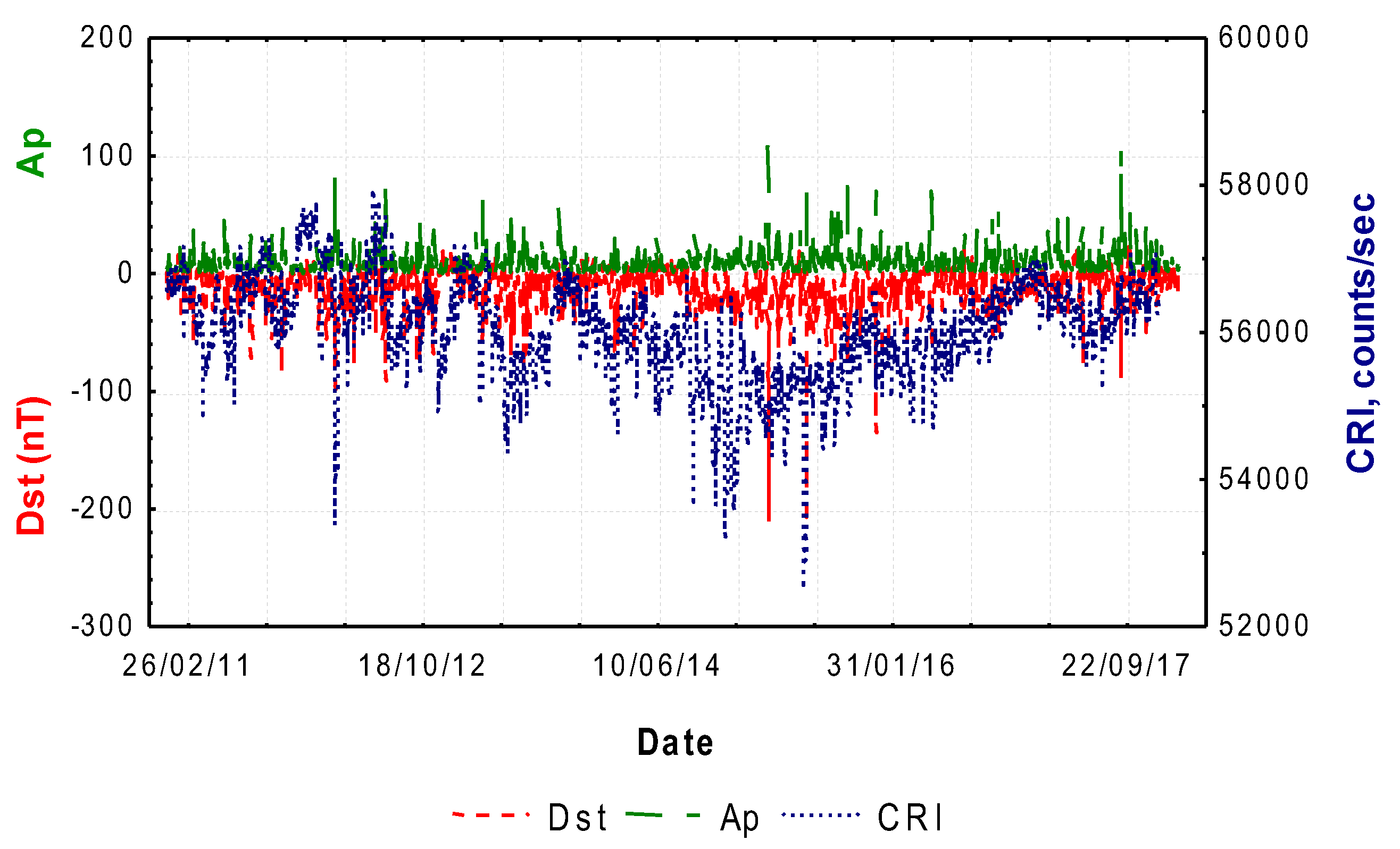
| Activity | Dst Levels | Dst Index Values (nT) | Number of Measurements (Women) | Number of Measurements (Men) | Ap Levels | Ap Index Values | Number of Measurements (Women) | Number of Measurements (Men) |
|---|---|---|---|---|---|---|---|---|
| Quiet | I0 | Dst ≥ 0 | 94 | 118 | I0 | Ap < 8 | 273 | 366 |
| Minor | I | −20 < Dst < 0 | 267 | 351 | I | 8 ≤ Ap < 15 | 125 | 168 |
| Moderate | II | −50 < Dst ≤ −20 | 145 | 194 | II | 15 ≤ Ap < 30 | 101 | 118 |
| Strong | III | −100 < Dst ≤ −50 | 27 | 23 | III | 30 ≤ Ap < 50 | 26 | 30 |
| Severe | IV | Dst ≤ −100 | 1 | 1 | IV | Ap ≥ 50 | 9 | 5 |
| p-Values | ||||||
|---|---|---|---|---|---|---|
| Men | Women | |||||
| Day | Dst | Ap | CRI | Dst | Ap | CRI |
| −3 | 0.60891 | 0.00814 * | 0.42217 | 0.03582 * | 0.97250 | 0.62050 |
| −2 | 0.97030 | 0.54366 | 0.37163 | 0.31232 | 0.05227 | 0.60271 |
| −1 | 0.29913 | 0.63379 | 0.26512 | 0.03914 * | 0.00012 * | 0.75154 |
| 0 | 0.87540 | 0.77509 | 0.23985 | 0.18530 | 0.52885 | 0.79933 |
| +1 | 0.52118 | 0.29504 | 0.11402 | 0.64163 | 0.52075 | 0.57080 |
| +2 | 0.40526 | 0.06567 | 0.34511 | 0.66130 | 0.37135 | 0.56819 |
| +3 | 0.55468 | 0.29899 | 0.83225 | 0.34803 | 0.04097 * | 0.78056 |
| Male Sex | Female Sex |
|---|---|
| p-values | |
| (1) Statistically significant results were acquired for geomagnetic index Ap three days before geomagnetic storms. | (1) Statistically significant results were acquired for the geomagnetic Ap index one day before and three days after the geomagnetic storm. |
| (2) No statistically significant results were obtained for geomagnetic index Dst. | (2) Statistically significant results were acquired for the geomagnetic Dst index one day and three days before the geomagnetic storm. |
| (3) No statistically significant results were obtained for CRI. | (3) No statistically significant results were obtained for CRI. |
| For different levels of geomagnetic and cosmic ray activity | |
| (4) For the geomagnetic Dst index, severe geomagnetic storms (level IV) were connected to an HR decrease. | (4) For the geomagnetic Dst index, severe geomagnetic storms (level IV) were connected to an HR increase. |
| (5) For the geomagnetic Ap index, the maximum HR value was recorded for level II (moderate GMA). High GMA levels (levels III and IV) were connected to low HR values. | (5) For the geomagnetic Ap index, the maximum HR value was recorded for level II (moderate GMA). High GMA levels (levels III and IV) were connected to low HR values. |
| (6) For the CRI variations, the maximum HR value was recorded for CRI decreases of −3%. For stronger CRI decreases and minor CRI decreases or CRI increases, HR had reduced values. | (6) For the CRI variations, the maximum HR value was recorded for CRI decreases of −3%. For stronger CRI decreases and minor CRI decreases or CRI increases, HR had reduced values. |
| During the development of an event | |
| (7) Regarding the geomagnetic Dst index, for low levels of GMA, i.e., levels I0, I and II, no significant HR variations were noticed. | (7) Regarding the geomagnetic Dst index, for level I0 (quiet period), HR varies during the event. |
| (8) Regarding the geomagnetic Dst index, for levels III and IV, HR had peak values on the days before and after the day of the event. | (8) Regarding the geomagnetic Dst index, for levels III and IV, HR had peak values on the days before the day of the event. |
| (9) Regarding the geomagnetic Ap index, for low levels of GMA, i.e., levels I0, I and II, no important HR variations were noticed. | (9) Regarding the geomagnetic Ap index, for low levels of GMA, i.e., levels I0, I and II, no important HR variations were noticed. |
| (10) Regarding the geomagnetic Ap index, for the highest level of GMA, i.e., level IV, the HR maximum and minimum values were recorded the days before the event. | (10) Regarding the geomagnetic Ap index, for the highest level of GMA, i.e., level IV, the HR maximum and minimum values for women were recorded the days after the event. |
| (11) Regarding CRI, the HR variations are more pronounced for CRI decreases from −5% to −3%. | (11) Regarding CRI, the HR variations are more pronounced for CRI decreases from −5% to −3%. |
| (12) Regarding CRI, for CRI decreases of −4%, HR has a minimum value one day before the event. For a CRI decrease of −3%, HR gets the maximum value one day after the event. | (12) Regarding CRI, for CRI decreases of −4%, HR has a maximum value one day before the event. For CRI decreases of −3%, HR gets a minimum value two days after the event. |
| (13) Regarding CRI, HR for CRI increases of +3% is noticeable. | |
Disclaimer/Publisher’s Note: The statements, opinions and data contained in all publications are solely those of the individual author(s) and contributor(s) and not of MDPI and/or the editor(s). MDPI and/or the editor(s) disclaim responsibility for any injury to people or property resulting from any ideas, methods, instructions or products referred to in the content. |
© 2024 by the authors. Licensee MDPI, Basel, Switzerland. This article is an open access article distributed under the terms and conditions of the Creative Commons Attribution (CC BY) license (https://creativecommons.org/licenses/by/4.0/).
Share and Cite
Papailiou, M.-C.; Mavromichalaki, H. Space Weather Effects on Heart Rate Variations: Sex Dependence. Atmosphere 2024, 15, 685. https://doi.org/10.3390/atmos15060685
Papailiou M-C, Mavromichalaki H. Space Weather Effects on Heart Rate Variations: Sex Dependence. Atmosphere. 2024; 15(6):685. https://doi.org/10.3390/atmos15060685
Chicago/Turabian StylePapailiou, Maria-Christina, and Helen Mavromichalaki. 2024. "Space Weather Effects on Heart Rate Variations: Sex Dependence" Atmosphere 15, no. 6: 685. https://doi.org/10.3390/atmos15060685





